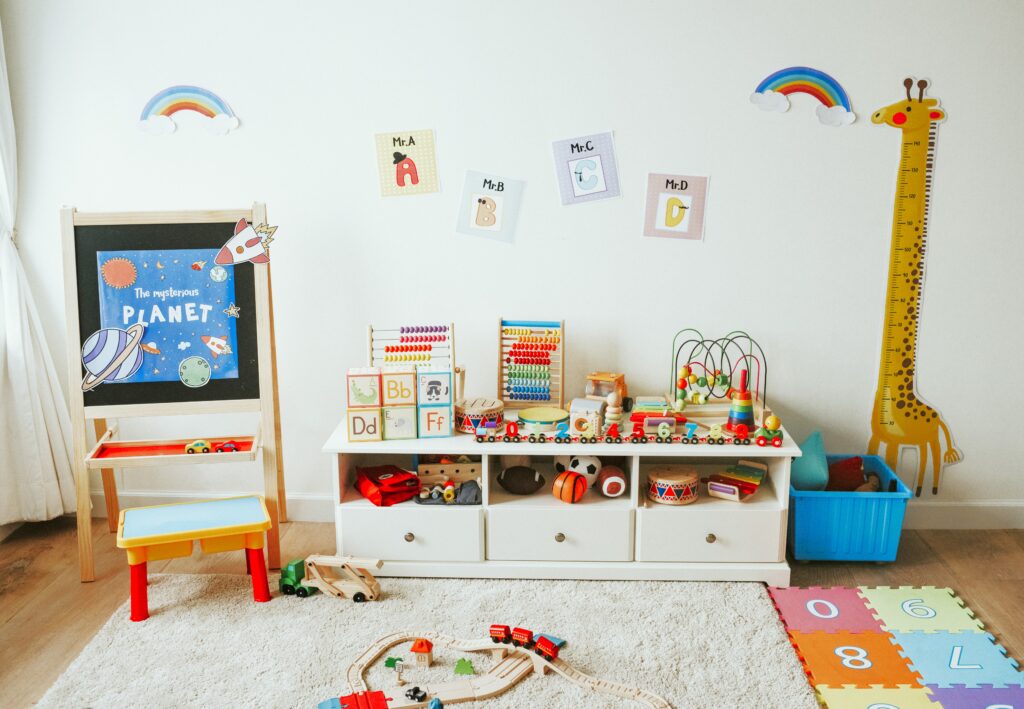Designing your children’s playroom is about more than just filling a space with toys. It’s about creating an environment that fosters creativity, learning, and endless fun. Whether you’re working with a small corner or a dedicated room, a well-designed playroom can become your child’s favorite place in the house. In this blog post, we’ll explore tips and ideas to create the ultimate playroom that balances functionality, safety, and style. 🎨🧸
1. Understanding the Importance of a Well-Designed Playroom

A children’s playroom is a sanctuary where little ones can express themselves, explore new ideas, and build memories. The right design can stimulate their imagination and encourage both independent and collaborative play. Beyond aesthetics, a thoughtful playroom setup supports physical and cognitive development, helping children learn and grow in a fun, engaging way.

2. Choosing the Right Color Palette for a Playroom

Color plays a crucial role in setting the tone of a playroom. Bright, cheerful colors like yellows, greens, and blues can create an energetic and positive atmosphere. However, it’s also important to balance these vibrant hues with neutral tones to avoid overstimulation.
3. Incorporating Safe and Functional Furniture

When selecting furniture for a playroom, safety is the top priority. Opt for furniture with rounded edges, non-toxic finishes, and sturdy construction. Multi-functional pieces, like storage benches or activity tables with built-in compartments, help keep the space organized while maximizing play space.
4. Creating Zones for Different Types of Play

Divide the playroom into different zones to cater to various activities. For example, a cozy reading nook with a bookshelf and bean bags, an art corner with easels and supplies, and a large open space for active play like building blocks or a play kitchen. These distinct areas help children transition smoothly between activities, keeping the playroom organized and engaging.
5. Incorporating Educational Elements

A well-designed playroom isn’t just about fun—it’s also a place for learning. Include educational toys, puzzles, and books that stimulate curiosity and cognitive development. Consider adding a chalkboard wall or magnetic board for creative learning activities.
6. Maximizing Storage for a Clutter-Free Space

A clutter-free playroom is essential for a stress-free environment. Utilize storage solutions like cubbies, baskets, and wall-mounted shelves to keep toys organized and accessible. Labeling bins and shelves can also teach children about organization and responsibility.
7. Adding Personal Touches to Make the Room Special

Personalize the playroom with elements that reflect your child’s interests and personality. This could be as simple as displaying their artwork, adding themed decor, or incorporating their favorite colors. Personal touches make the space feel special and encourage children to take ownership of their play area.
8. Ensuring Flexibility for Future Growth

Children grow quickly, and their interests change over time. Design the playroom with flexibility in mind, using modular furniture and decor that can be easily updated as your child’s needs evolve. This approach ensures that the playroom remains a favorite space for years to come.
Crafting a Playroom That Grows with Your Child
Creating a children’s playroom is an exciting opportunity to design a space that encourages learning, creativity, and fun. By focusing on safety, functionality, and flexibility, you can craft a playroom that not only meets your child’s current needs but also adapts as they grow. With the right design, your child’s playroom can become a cherished part of their childhood memories.

By incorporating these elements into your design, you’ll create a playroom that’s not only practical and safe but also a joyful place where your child can thrive. 🌟
